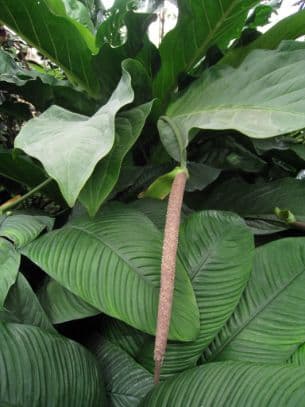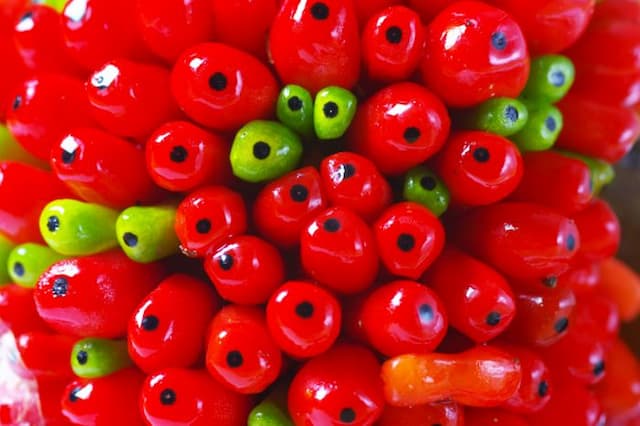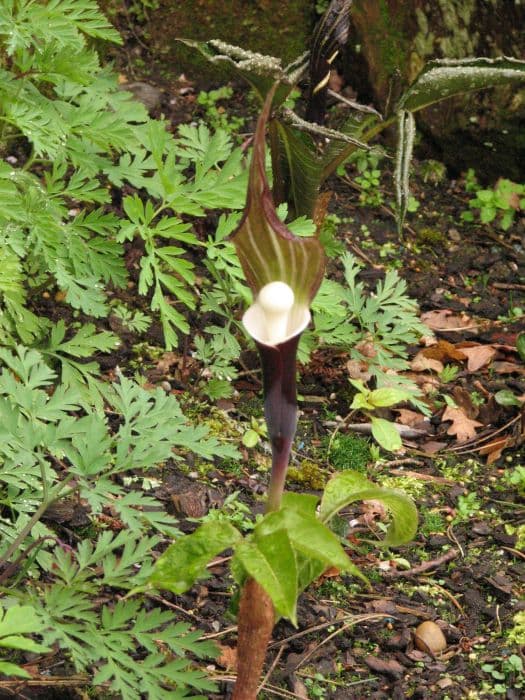Calla Lily 'Gold Medal' Zantedeschia 'Gold Medal'

ABOUT
The plant known as Calla Lily 'Gold Medal' features a striking appearance that is characterized by its bold and beautiful flowers. It has a spade-like shape, known as a spathe, which is often mistaken for a petal due to its vivid coloration. The actual flower is a spike in the center, called a spadix, which is surrounded by the spathe. The 'Gold Medal' variety of Calla Lily has a particularly vibrant color palette, where the spathe radiates a deep golden hue that can sometimes appear brushed with creamy or yellowish tones. The foliage of 'Gold Medal' is also quite attractive. The leaves are large and arrowhead-shaped, displaying a rich green color that often has a glossy or waxy finish. The leaves provide a lush backdrop that further accentuates the brilliance of the golden spathes. Additionally, the plant has a graceful form, with an elegant, streamlined appearance that adds a sense of sophistication and tropical flair to gardens or indoor spaces. Overall, the Calla Lily 'Gold Medal' is cherished for its dramatic and exotic flowers, lush foliage, and the elegant splash of color it brings to its surroundings.
About this plant
 Names
NamesFamily
Araceae
Synonyms
Calla Lily, Arum Lily
Common names
Zantedeschia 'Gold Medal'.
 Toxicity
ToxicityTo humans
Calla lily, including Zantedeschia 'Gold Medal', is considered toxic to humans if ingested. The plant contains calcium oxalate crystals which can cause irritation and a burning sensation in the mouth and throat, difficulty swallowing, and nausea, vomiting, or diarrhea if ingested. In severe cases, ingestion may lead to difficulty breathing or swallowing, requiring immediate medical attention.
To pets
Calla lily is toxic to pets such as dogs and cats. Ingesting any part of the plant can cause symptoms like oral irritation, excessive drooling, vomiting, difficulty swallowing, and in severe cases, a burning sensation in the mouth, difficulty breathing, or swallowing can occur. If a pet consumes part of a Calla lily, immediate veterinary attention is recommended.
 Characteristics
CharacteristicsLife cycle
Perennials
Foliage type
Deciduous
Color of leaves
Green
Flower color
Yellow
Height
2-3 feet (0.6-0.9 meters)
Spread
1-2 feet (0.3-0.6 meters)
Plant type
Herb
Hardiness zones
8
Native area
Africa
Benefits
 General Benefits
General Benefits- Easy to Grow: Zantedeschia 'Gold Medal', commonly known as Calla Lily, is relatively easy to grow in the right conditions, requiring minimal care beyond proper watering and light exposure.
- Ornamental Appeal: The plant's elegant trumpet-shaped flowers and attractive foliage make it a popular choice for ornamental purposes in gardens and as cut flowers for arrangements.
- Perennial Growth: As a perennial, the Calla Lily returns year after year, providing long-term value and beauty in a garden setting.
- Wide Variety of Uses: Ideal for use in flower beds, borders, containers, and water gardens due to its versatility and range of colors.
- Attracts Wildlife: The flowers can attract beneficial insects, such as butterflies, adding an extra layer of interest and biodiversity to the garden.
- Adaptable: While they prefer moist environments, Calla Lilies can adapt to a wide range of soil conditions if proper care is given.
- Seasonal Interest: Blooming in late spring to early summer, they provide a seasonal highlight and can be coordinated with other plants to ensure continuous bloom in the garden.
 Medical Properties
Medical PropertiesThis plant is not used for medical purposes.
 Air-purifying Qualities
Air-purifying QualitiesThis plant is not specifically known for air purifying qualities.
 Other Uses
Other Uses- Photography prop: The Zantedeschia 'Gold Medal', commonly known as Calla Lily, with its distinctive shape and color, can be used as a beautiful subject or backdrop in floral photography.
- Art inspiration: Artists may use the elegant form of the Calla Lily as inspiration for paintings, sketches, and sculptures.
- Educational model: Biology teachers could use the plant to demonstrate flower parts to students, as its large spadix and spathe are easily distinguishable.
- Water garden plant: The Calla Lily can be grown in shallow water, adding an exotic touch to water gardens or ponds.
- Dye source: The pigments in the Calla Lily's flowers could potentially be used to create natural dyes for textiles or crafts.
- Wedding theme centerpiece: Its striking appearance makes the Calla Lily a popular choice for wedding decorations and themed events.
- Eco-friendly confetti: Dried Calla Lily petals can be used as biodegradable confetti for outdoor celebrations.
- Craft material: The strong, flexible stems of the Calla Lily can be used in crafting, such as in making wreaths or other decorative items.
- Fragrance extraction: While not as common as other flowers, the scent of the Calla Lily could be used in the creation of perfumes or aromatic oils.
- Symbolic gift: Due to its association with purity and beauty, Calla Lilies are often given as gifts on meaningful occasions to convey special messages.
Interesting Facts
 Feng Shui
Feng ShuiThe Calla Lily is not used in Feng Shui practice.
 Zodiac Sign Compitability
Zodiac Sign CompitabilityThe Calla Lily is not used in astrology practice.
 Plant Symbolism
Plant Symbolism- Purity and Innocence: The clean and elegant look of the Calla Lily, to which Zantedeschia 'Gold Medal' belongs, is often associated with notions of purity and innocence. This makes it a popular choice for weddings and religious ceremonies.
- Resurrection and Rebirth: Its trumpet-like flowers can symbolize triumph and are often used in Easter services to represent the resurrection of Jesus, thus signifying rebirth.
- Divine Beauty: With its striking appearance, the Calla Lily is also said to embody divine beauty or a conveyance of beauty on a higher, spiritual level.
- Overcoming Challenges: Its growth from a bulb in often muddy environments to a beautiful flower can be seen as a metaphor for overcoming challenges or difficulties in life.
- Transcendence: The Calla Lily's shape and form give it a surreal quality, which can suggest a sense of transcendence or transcending the ordinary.
- Faith and Purity of Heart: Because of its white color and association with the Virgin Mary in Christian iconography, the Calla Lily sometimes represents faith and purity of heart.
- Noble Intentions: Presenting someone with a Calla Lily may indicate a recognition of their noble intent or a bestowal of honor and respect.
 Water
WaterCalla lilies, including the Zantedeschia 'Gold Medal', prefer being watered thoroughly once the top inch of soil feels dry to the touch; this usually means watering once a week, though this frequency may increase during hot, dry spells. To water properly, pour water slowly at the base of the plant until it's saturated and the excess water drains from the bottom of the pot. Each plant will typically require about one gallon of water every seven to ten days, but always be wary of waterlogging as calla lilies do not like to sit in water.
 Light
LightCalla lilies thrive in bright, indirect sunlight and will do well placed in a spot that receives this light for most of the day. Avoid direct sunlight, especially during the hot afternoon hours, as it can scorch the leaves. North or east-facing windows are typically good spots for these plants, ensuring they get ample light without the harshness of the midday sun.
 Temperature
TemperatureCalla lilies enjoy temperatures between 60 and 75 degrees Fahrenheit but can survive in temperatures as low as 50 degrees and as high as 80 degrees Fahrenheit for short periods of time. The ideal temperature conditions for this plant involve avoiding drastic temperature fluctuations and keeping it away from drafts.
 Pruning
PruningPruning calla lilies mainly involves removing spent flowers to encourage new blooms and cutting back the foliage after it turns yellow, indicating the plant is entering dormancy. Pruning is typically done after blooming, which varies depending on your climate but often occurs in late summer or early fall.
 Cleaning
CleaningAs needed
 Soil
SoilThe Calla Lily 'Gold Medal' thrives in a well-draining, rich potting mix with a pH of 5.5 to 6.5. A mix of peat, perlite, and compost is ideal for retaining moisture while allowing excess water to drain.
 Repotting
RepottingCalla Lilies, including 'Gold Medal', should be repotted every two years or when they outgrow their current container to ensure continued growth and bloom.
 Humidity & Misting
Humidity & MistingCalla Lily 'Gold Medal' prefers high humidity conditions, ideally between 60-70%, for optimal growth.
 Suitable locations
Suitable locationsIndoor
Provide bright, indirect light and keep soil moist for Calla Lily 'Gold Medal'.
Outdoor
Plant in partial shade, keep soil moist, and protect from frost for 'Gold Medal'.
Hardiness zone
8-10 USDA
 Life cycle
Life cycleThe life cycle of the Zantedeschia 'Gold Medal', commonly known as the Calla Lily 'Gold Medal', begins with seed germination or vegetative propagation through division of rhizomes. The plant then enters a growth phase where it develops long, arrow-shaped leaves and eventually produces a distinct spathe, a flaring trumpet-shaped bract that surrounds the spadix (flower spike). After pollination, which is often facilitated by insects, the plant produces berries containing seeds, completing its reproductive cycle. During its growing season, the Calla Lily 'Gold Medal' requires plenty of water and good sunlight to flourish. As it enters dormancy, typically triggered by cooler temperatures and shorter daylight hours, the plant's foliage dies back, and the rhizome rests underground. With the return of warmer weather and longer days, the cycle begins anew as the rhizome sends up new growth, reinitiating the life process.
 Propogation
PropogationPropogation time
Spring-Early Summer
The Zantedeschia 'Gold Medal', commonly known as a cultivar of Calla Lily, can be propagated through division, which is the most popular method for this ornamental plant. The ideal time for this form of propagation is in the fall, after the foliage has died back, or in the spring before growth begins. To propagate by division, carefully lift the rhizomes from the ground using a garden fork, ensuring that each division has at least one growing point or "eye". These divisions can then be replanted immediately in well-draining soil at a depth of about 4 inches (approximately 10 centimeters). Water the newly planted rhizomes sparingly until new growth appears, signifying that they have successfully established themselves and started to grow.









